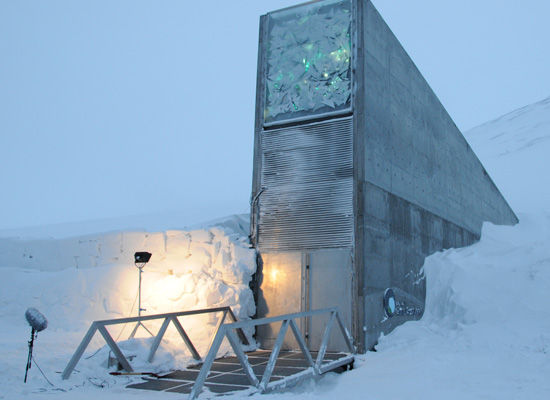Seed Banking for Survival—Saving the World, One Seed at a Time
It's no accident that most of the largest seed banks are operated by governmental agencies. Seed banking can be an expensive practice, and the most far-reaching programs are those fueled by economic incentives.
Booming population growth and the attendant need for stable food crops ramps up the homogeneity of plant life. The health and vigor of a plant strain, however—whether food crop, forage, or rare species—depends on diversity. But industrial agriculture, which focuses on the mass production of a single crop variety, drastically reduces genetic diversity within the plant population. While around 7,000 different plant species have been raised as food crops since the beginning of human agriculture, according to the United Nations Convention on Biological Diversity, a mere 15 plant species now make up about 90 percent of all human food crops. Chief among these are rice, wheat, and maize, which account for two-thirds of that 90 percent.
Bred for uniform traits, agricultural monocultures become vulnerable to disease and pests. Examples include the 1970 loss of $1 billion worth of crops in the U.S. when disease killed uniform corn varieties, and the massive outbreaks of citrus canker in Florida in 1984 and Brazil in 1991, both exacerbated by the loss of traditional varieties and, thereby, genetic diversity.
Seed banks keep diversity alive in the face of intensive agriculture and genetically modified seeds. They also provide source material for plant breeders and researchers in search of genetic traits for new crop varieties—qualities such as enhanced nutritional value, higher yields, resistance to pests and diseases, and the capacity to weather climate change with its predicted intensification of both floods and drought.
Plant breeders use seed-bank stores to find cultivars that can resist things like black Sigatoka fungus, which devastated banana production in East Africa. One seed bank, the International Rice Research Institute, was able to supply the farmers of tsunami-devastated Asia with rice varieties that would grow in fields that had been inundated with saltwater.
Like natural disasters, war can quickly decimate regional agricultural systems, and stock from seed banks can be crucial to restoring crop plants. The International Center for Agricultural Research in the Dry Areas, located in Aleppo, Syria, holds varieties native to Afghanistan and Iraq among the 135,000 food and forage seeds in its collection. The collection has been an important source of seeds to help revitalize crop diversity damaged by war.
Banking for Biodiversity
Plants in the wild, prey to massive habitat loss, are also disappearing. Thousands of plant varieties, noncommercial crops and wild plants alike, have gone extinct. Since 1900, among agricultural crops alone, the Food and Agriculture Organization of the United Nations estimates that 75 percent of the world's genetic diversity has been eliminated.
The Millennium Seed Bank Project (MSBP) of the Royal Botanic Gardens, Kew, focuses on the conservation of wild plant species. Along with its global partners, MSBP is working toward securing 25 percent of the world's plant species in safe storage by 2020. Their current project, which runs until 2010, includes the collection of seeds, specimens, and data from 24,200 wild species worldwide, preserving them both in their countries of origin and at the Millennium Seed Bank and making them available for research use and conservation in the wild.
Among the MSBP's many wild species success stories are marsh pagoda (Mimetes hirtus), a flowering shrub found in limited regions of Africa and classified as vulnerable, and cabbage tree (Dendroseris litoralis), one of the most endangered plant species on the planet. A cabbage tree specimen flowered at the MSBP in 2004, an important milestone in bringing the plant back from the brink of extinction.
There are also many regional and community seed banks and networks that operate either in partnership with or independently of larger projects like MSBP. Organizations such as the Kusa Seed Society bank seed for the restoration of native species and the preservation of local diversity. Some, like the Seed Savers network of Australia, actively resist the dominance of the larger seed bank projects, seeing them as exclusively serving the concerns of big agriculture to the detriment of the most traditional method of preserving crop diversity—farm and community seed swapping and storing, practices that they argue have been carried on for over 10,000 years.
Closer to home, many botanic gardens do the work of seed banking for regional plant conservation, and independent efforts like the Experimental Station seed archive project in Chicago collect and lend seeds for plants used for food, medicines, and building materials.
Doomsday Is Every Day

According to Carey Fowler, “If we had built this vault a decade ago, we would have used it ten times already.” As backup for seed banks the world over, Svalbard stores are ready when anything from equipment failure to flooding causes a loss at the seed banks that originally placed collections with the Global Seed Vault. “Doomsday,” Fowler warns, “is every day.”
Regional and Community Seed Banks
There are many small, regional seed banks, whose mission is to preserve the diversity of those plants native to their areas, as well as projects focused on community outreach or saving particular kinds of plants. For more information, check out these organizations:
Exchange Networks and Outreach
Regional Focus
- Center for Indian Knowledge Systems Seed Bank Project
- Ozark Seed Bank
- Saving Our Seeds
- Seed Bank of New England Wild Flower Society


